What Is Kyber Network?
Kyber Network is an Ethereum-based protocol that permits the "moment trade and transformation of computerized resources (e.g. crypto tokens) and digital currencies (e.g. Ether, Bitcoin, ZCash) with high liquidity." Kyber is like the 0x venture however rather plays out every one of its activities on the blockchain.
Unified trades are always under flame for their security vulnerabilities and moderate process times. In a few occurrences, it could take days to pull back your assets from a trade. Mainstream decentralized trades remain imperfect too. They generally don't have enough liquidity to help dynamic exchanging, and expenses to change an exchange can be high when the request book is kept on-chain.
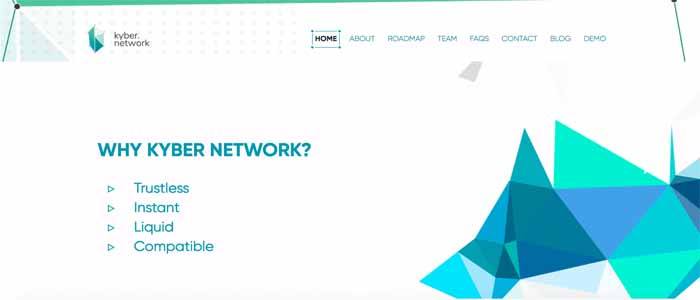
Kyber Network provides a decentralized, on-chain exchange, but removes the order book. This gives the platform the ability to securely exchange your crypto instantaneously at minimal cost.
- Overview - Table of Contents
- What Is Kyber Network?
- Getting Started With Kyber Network
- How To Get A Kyber Network Wallet?
- Kyber Network Resources
- How To Buy Kyber Network?
- How To Earn Kyber Network?
- Latest Kyber Network News
Other than a trade, Kyber Network is utilized as a medium to exchange tokens from individual to individual. This is extraordinary for p2p exchanges and in addition ICOs. The tokens that a man sends doesn't need to coordinate the particular token that the beneficiary needs to… get. Kyber does the trade amid the exchange. How about we take a gander at a snappy illustration:
Simple Kyber Network Transfer
Sway owes Sally 0.01 ETH for a lodging room they split out of town. Sadly, Sway just has REP. Sally truly needs ETH, not REP, so they utilize the Kyber convention to settle the exchange.
Sway sees on the Kyber Network interface that the change rate for the exchange is 1 ETH = 16 REP.
He enters a demand to Kyber to change over 0.01 ETH worth of REP and send it to Sally. The Kyber contract (what controls the token save distribution center) first watches that Sway sufficiently included REP in the agreement for the transformation.
After endorsement, the agreement at that point sends the 0.01 ETH to Sally's address. With the Kyber Network standard contract wallet, it will appear to Sally as though the assets came straightforwardly from Sway's address.
Ultimately, Sway's REP, in addition to a little expense, is added to the hold pool in which the ETH began.
Kyber Network Roles
There are a few different roles in Kyber Network you should be aware of:
- Users send and receive tokens to/from the network. They can be individuals, merchants, or smart contract accounts.
- Reserve Entities bring liquidity to the platform. They can be internal or hosted by a registered third-party. They’re classified as public or private depending on whether or not the public contributes to their reserves.
- Reserve Contributors provide funds to the Reserve Entities. They’re only associated with public Reserve Entities and share the profits from the reserve.
- The Reserve Manager maintains the reserve, calculates exchange rates and enters them into the network.
- The Kyber Network Operator adds/removes Reserve Entities as well as controls which tokens are listed. Initially, the Kyber team will play this role, but eventually, it will switch to a proper decentralized governance.
All of these roles interact with the Kyber Network smart contract differently.
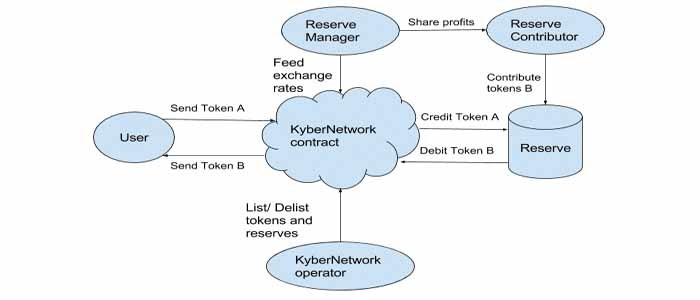
Dynamic Reserve Pool
Kyber Network keeps up liquidity through the dynamic save pool. The pool contains the greater part of the Reserve Entities in the framework. Having different substances in the pool anticipates imposing business model and keeps trade rates focused. At the point when a client asks for a trade, the Kyber shrewd contract makes the trade through the Reserve Entity with the best conversion scale for the client.
By permitting outside Reserve Entities, Kyber Network avoids centralization and opens the way to low-volume token postings. Outside stores might approve of going out on a limb of putting away less well known tokens that the Kyber holds don't list.
To anticipate terrible performing artists in the hold pool, Kyber Network has few protections. The system will hail any swapping scale for extraordinary endorsement that is extraordinarily outside the standard. To ensure subsidizes in an open save, Kyber makes all trades utilizing them accessible through a straightforward store administration show. Moreso, open stores will in all probability just have the capacity to send assets to predefined addresses too.
Save Managers acquire benefit through the spreads they set for their stores. They likewise get the advantage of expanded volume by taking advantage of the general Kyber Network and also a Kyber-if dashboard to deal with their hold.
Kyber Network's vision is strong, however transforming it into a working undertaking is something unique totally. With a fundamental spotlight on trustless arrangements, moment administrations, and high liquidity, there is a great deal of work to be finished by the designers. Dissimilar to the incorporated trade demonstrate, Kyber Network plans to expel all security vulnerabilities from the condition. With no concentrated stage, logins, or character check records exhibit, there is no data to be stolen from a brought together substance.
On-chain decentralized trades are gradually ending up more present in the realm of digital currency. Despite the fact that the majority of these ideas are still in the beginning periods of advancement, there are a few arrangements available as of now. It will enthusiasm to perceive how well Kyber Network performs in such manner, as the expulsion of a brought together interface regularly implies arrangements like these are less helpful for clients. Exchanges are apparently basic, however, as the convention has an interface in any case.
Liquidity suppliers on the Kyber Network are known as hold elements, though the general population giving assets to these substances are known as Reserve Contributors. There's likewise a Reserve Manager, which will appear as a Kyber Network contract to keep up the trustless idea of this convention. This same contract can likewise include and expel Reserve Entities if necessary, which is truly intriguing. Liquidity on the convention will be kept up through a dynamic save pool to keep imposing business models from framing later on.
The year 2018 will be quite huge for Kyber Network all in all. Amid the primary quarter, we will witness the principal mainnet dispatch which will bolster exchanging between different tokens and Ethereum. Discretionary token sets will be included the following quarter, trailed by cutting edge monetary instruments in the not so distant future. Cross-chain exchanging won't go live until mid 2019, which implies the majority of the work still can't seem to be finished. It gives individuals parts to anticipate, however.
Getting Started With Kyber Network
Kyber Network is a decentralized trade that just went live on the Ethereum blockchain. Kyber Network is a standout amongst the most expected undertakings leaving Singapore, along these lines, since my entry, I've invested a considerable measure of energy investigating precisely what it is that they're building. At first look, they're fabricating a trade for exchanging cryptographic forms of money that utilizations shrewd contracts and an arrangement of stores to ensure moment exchanges.
A more profound look uncovers that the Kyber Network trade has an optional capacity past exchanging one resource for another. The trade will likewise be utilized to encourage cryptographic money installments, which would one be able to day convey interoperability to a world where a huge number of digital currencies exist.
I asked CEO Loi Luu (articulated LOY LOO) what Kyber Network will look like in 5 to 10 years in the event that it accomplishes its objectives. His answer? "Kyber Network will be a half and half of the NASDAQ and Visa. An exceedingly fluid trade for exchanging crypto resources that serves as a facilitator for digital currency based installments."
Extensive aspirations in fact. Before I plunge into the importance of Loi's announcement, some presentation is required.
CEO Loi Luu
Chances are you've never knew about this 26 year old from the Vietnamese capital of Hanoi... unless you're an Ethereum designer or an Asia-based blockchain speculator. Loi Luu kept in touch with a portion of the principal scholarly papers on Ethereum while getting his PhD in Computer Science from The National University of Singapore.
Before beginning Kyber Network, Loi fabricated a device for investigating and distinguishing security imperfections in Ethereum smart contracts called Oyente. He likewise established Smart Pool, which is a decentralized mining pool. Loi has been modifying since the seventh grade and in light of his resume, absolutely feels comfortable around a PC.

Advisor Vitalik Buterin
One of the reason's there's a lot of buzz around Kyber Network is because of this guy's face on their website:

In the realm of digital currency, anything Ethereum maker Vitalik Buterin touches draws in a considerable measure of consideration. Truth be told, there was a brief period where tokens were spiking in an incentive after the authors would get their photo taken with Vitalik and post it to their web-based social networking channels. Vitalik's relationship with Kyber is somewhat more authentic than that.
After Loi composed his first scholastic paper on Ethereum in 2015, he sent it to Vitalik who answered with input. After their underlying correspondence, Loi would send and talk about the majority of his future papers and Ethereum related undertakings with Vitalik.
- Overview - Table of Contents
- What Is Kyber Network?
- Getting Started With Kyber Network
- How To Get A Kyber Network Wallet?
- Kyber Network Resources
- How To Buy Kyber Network?
- How To Earn Kyber Network?
- Latest Kyber Network News
In mid-2015, Vitalik went to Singapore where the two met and talked about the eventual fate of Ethereum. The two stayed in touch and when Loi began Kyber Network, he requested that Vitalik be a consultant. To some degree broadly, Vitalik promised that Kyber Network and OmiseGo, would be the last tasks he would exhort.
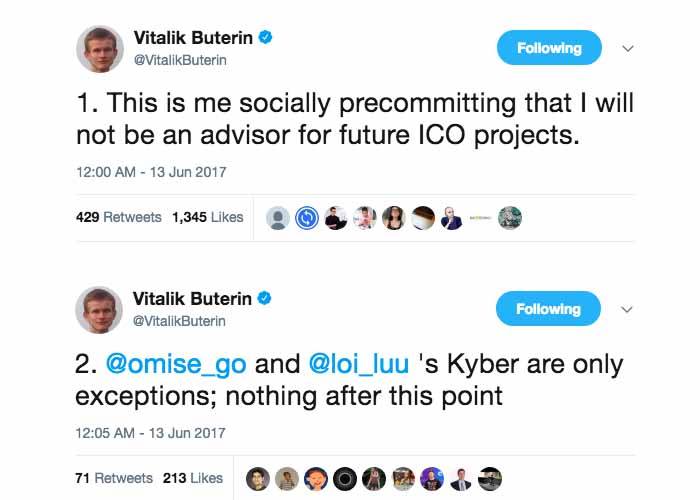
Vitalik is not involved in the day to day operations, but was involved in the early discussions on how Kyber Network should be structured. The team pointed out that it's no coincidence that Kyber Network fits Vitalik's definition for what a decentralized exchange should be.
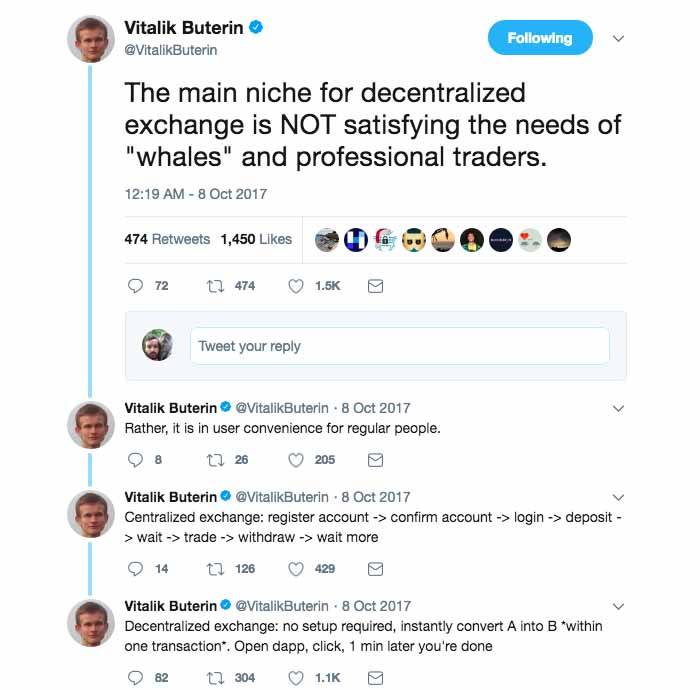
A Deep Dive into Kyber Network
It's important to first understand why Kyber, along with projects like 0x and AirSwap, are all building decentralized exchanges. From there, we'll take a deep look at how Kyber's exchange will function. After that, we'll see how Kyber's exchange will also function as a payment facilitator.
The Problem With Centralized Exchanges
In 2014, the world's first cryptocurrency exchange called Mt. Gox was hacked for $460 million worth of bitcoin. In 2016, hackers got away with $72 million worth of bitcoin from the Bitfinex exchange. In January of this year, the biggest hack to date occurred when $562 million worth of the cryptocurrency NEM was stolen from the Coincheck exchange. The Friday before Kyber went live, $170 million worth of a cryptocurrency called Nano was stolen from the BitGrail exchange.
These hacks happen because major exchanges hold massive amounts of cryptocurrencies on behalf of their users in a central location - thus, they are "centralized" exchanges. Cryptocurrencies use a combination of what are called public and private key encryption to function. These keys are long, randomly generated strings of characters that allow people to send and receive cryptocurrency. If someone is going to pay you, they direct the payment to your public key. If you want to pay someone else, you need your private key to authorize the transaction. If a hacker gets a hold of your private key, they can authorize transactions to cryptocurrency wallets that they control.
Exchanges hold millions of dollars of its users' funds in wallets on a central server. If a hacker can breach that server and steal the exchange's private keys, they can move everyone's funds out of the exchange and into a wallet controlled by the hacker.
The Decentralized Difference
Decentralized exchanges facilitate trades without ever taking custody of users' funds. They do this by using smart contracts executed on blockchain networks like Ethereum to enable trades peer-to-peer. If I want to trade 1` Ethereum for 70 OmiseGo tokens, the smart contract finds someone willing to part with 70 OmiseGo tokens in exchange for 1 Ethereum and makes the swap directly. The instant the Ether leaves my wallet I receive the OmiseGo; the funds are never in the custody of the exchange.
This exchange is decentralized because it consists of smart contracts that live on a blockchain network. The trades are executed by computers (miners) all over the world rather than on a central server - there is no single point of failure for a hacker to attack.
Of the decentralized exchanges being introduced (0x, Airswap and Kyber) Kyber is arguably the most decentralized since it runs completely on the Ethereum blockchain. While 0x and Airswap don't take custody of user funds, their smart contracts match buyers and sellers by consulting order books maintained on central servers. If these order books were compromised, it could be problematic for users. All trades on Kyber Network take place 100% on the Ethereum blockchain.
The Liquidity Problem
There are already several decentralized exchanges on the market. Despite the obvious security advantages, none currently handle significant volume. Decentralized exchanges like EtherDelta and IDex only handle about $4 million in trade volume per day. This is very low when compared to major centralized exchanges like Binance and Bithumb that handle billions every day. The major problem that stems from trading on an exchange with low volume is the lack of liquidity.
Liquidity measures the ease of buying or selling a particular asset at a stable price. Selling traditional stocks like shares of Apple Inc. on the Nasdaq is a highly liquid market because at any given time, there are plenty of people willing to purchase the stock from you at the going market rate. An example of a highly illiquid market would be selling refrigerators in exchange for toasters on Craigslist. Odds are at any given time, there aren't a lot of people on Craigslist looking to sell their toasters in exchange for refrigerators so you're going to have a tough time making that trade happen.
While this is a silly example, if you're trying to trade cryptocurrency on an exchange with low volume, it can feel like trading refrigerators for toasters on Craigslist. On a low volume exchange that suffers from low liquidity, finding someone to trade with takes a much longer time and the users often have to settle for undesirable prices.
Kyber's solution to the liquidity problem? Guarantee it through a system of reserves.
Kyber Reserves
The Kyber Reserve system is where Kyber Network differentiates itself from the rest of the decentralized exchanges on the market. You can think of a Kyber Reserve as a big pool of cryptocurrencies that are always available for trading. The equivalent in the traditional finance world is called a "market maker."
In foreign exchange markets, a market maker for the currency pair [Japanese Yen/US Dollar] is someone who has a lot of Yen and US dollars available for trade at all times. If an institution thinks that the USD is going to weaken and the Yen will strengthen, they can sell their USD to the market maker in exchange for Yen. The market maker profits through the "spread." If 1 USD = 100 Yen and the spread is $0.05, the market maker will profit 5 cents by accepting $1.05 in exchange for 100 Yen. There are usually multiple market makers who compete against one another for business by offering the best rates and the lowest spread.
Kyber Reserves will function in the same way but with cryptocurrency pairs. Anyone with a lot of OmiseGo and Ether could be an [OMG/ETH] market maker by committing their funds to a Kyber Reserve. The reserve manager will set the rates in which they're willing to trade OmiseGo for Ether and vice versa and will set their own spreads. These reserves will always be available to users of the Kyber Network for trading. Kyber's goal is to have multiple reserves for each pair that will compete for business by offering the best rates with the lowest spreads.
Who Will These Market Makers Be?
Foreign exchange market makers tend to be people with a lot of spare currencies lying around who want to put their idle assets to work - typically banks and financial institutions. Similarly, Kyber Network Reserve managers can be anyone with large stockpiles of cryptoccurrency. This could hypothetically be any of the following:
- Whales - Whale is a term for an individual with huge stock piles of cryptocurrency. A whale could commit their funds to a Kyber Reserve and profit from the spread.
- Centralized Exchanges - Exchanges like Binance or Bittrex that collect millions in transaction fees in various cryptocurrencies could profit from managing Kyber Reserves.
- Fund Companies - Companies that invest in ICOs can put their assets to work by establishing Kyber Reserves.
- Project Founders - Founders of new cryptocurrencies all face the task of getting their token into circulation. A way for token issuers to do that could be to establish Kyber Reserves of their own coin to give the market access to it.
How To Get A Kyber Network Wallet?
To set up a Kyber Reserve, the reserve manager commits funds of any two cryptocurrencies to an account connected to a Kyber Network smart contract. Kyber has built software that allows the reserve manager to set their own spreads and rates. Kyber is not the custodian of these funds.
According to Loi, a small amount of reserves can support a large amount of trading. Let's say a reserve contributor commits 150 Ether and an equivalent amount of OmiseGo (11,000 OMG at current rates). If a user wants to buy 1 Eth for 70 OMG tokens, the reserve receives 70 OMG tokens and loses 1 ETH. If a user wants to buy 70 OMG for 1 Eth, the reserve will lose 70 OMG and gain 1 ETH. Under market conditions where Kyber users are buying and selling similar levels of Ether and OmiseGo, the reserve will maintain its initial level of both ETH and OMG and can maintain a trading volume that exceeds its total contribution (i.e. 150 Eth /11,000 OMG reserve can support 1,500 ETH / 110,000 OMG trade volumes).
If Kyber users start heavily selling Ether to buy OmiseGo, this would cause the reserve's OMG levels to deplete and its Ether levels to accumulate. This is where Kyber's rebalancing feature kicks in. The Kyber Reserve software has a function that uses a combination of trading bots and smart contracts connected to major exchanges like Binance, Bittrex and Huobi.
In the scenario described above, Kyber's automated software would trade the excess Ether for OMG with the centralized exchange offering the best rate to bring the reserve back to its original levels. This lets reserve managers profit from their assets while still maintaining their original investment.
Kyber Network Crystals - KNC
Kyber Network's native asset is the Kyber Network Crystal (KNC) which is an essential part of the reserve system. To earn the right to profit from spreads on the Kyber Network, Kyber Reserve managers are required to purchase KNC. When a reserve completes a trade and profits from the spread, a percentage of that profit is paid to the Kyber Network in KNC.
- Overview - Table of Contents
- What Is Kyber Network?
- Getting Started With Kyber Network
- How To Get A Kyber Network Wallet?
- Kyber Network Resources
- How To Buy Kyber Network?
- How To Earn Kyber Network?
- Latest Kyber Network News
Kyber Network uses the KNC to pay for its operating costs and to pay its supporters. For example, a wallet that integrates with Kyber Network will get a percentage of the KNC payment as a referral fee for sending a user to the network. Once supporters and operating costs are paid, the remaining KNC is "burned", which means that its taken out of circulation. As more reserves are opened and the total supply of KNC is gradually lowered due to the token burning, demand for KNC tokens should increase over time.
If you are speculating on KNC, you are rooting for a robust network of Kyber Reserves because demand for KNC tokens is proportional to the amount of reserves in operation.
Trading on Kyber Network
While Kyber Network will allow whales, exchanges and funds to profit from their idle assets, the exchange was built with convenience of the end user in mind. Users will be able to easily connect to the Kyber Network without setting up an account through the following ways:
- Hardware Wallets - Users can go to the Kyber Network website and directly connect their Trezor or Ledger Nano hardware wallets
- Software Wallets - Users of software wallets that integrate with Kyber Network will be able to connect directly from their wallet. So far, Kyber's list of wallet partners includes ImToken, Coin Manager and Trust Wallet. Once Kyber is available to the public, users of these wallets will see the Kyber option in the wallet's user interface.
Once connected to the Kyber Network via hardware or software wallet, trading is very simple. The user will see all of the trading pairs offered by Kyber Network. Any pair that a user sees will have at least 2 supporting reserves and will be available for instant trading.
If the user wants to trade Ether for OmiseGo tokens, they will select the ETH/OMG trading pair and enter the amount of Ether they want to exchange. Users will be presented with a price suggested by Kyber Network that reflects the going market rate, but will have the option of selecting the minimum rate that they are willing to accept.
The user has to pay a small amount of Ether to the Ethereum network for handling the transaction - this is called a "gas" fee and is paid to the Ethereum miner who ultimately adds the transaction to the Ethereum blockchain. With the exchange rate and the gas fee set, the user presses "exchange".
From there, the Kyber Network smart contract goes to work. If I indicated that 60 OMG tokens was the minimum I was willing to accept in exchange for 1 Ether, the Kyber Network smart contract takes that information and finds the best rate offered by the various [ETH/OMG] reserves. If one reserve is offering 60 OMG per 1 Ether and another is offering 65 OMG, the smart contract will select the 65 OMG rate.
Once the smart contract identifies the best rate, this transaction is broadcasted to the Ethereum network. Once the transaction is added to a block in the Ethereum blockchain by a miner, my wallet is credited 65 OMG tokens and debited 1 Ether plus the gas fee. The swap from Ether to OmiseGo happens simultaneously and at no point are my funds in the custody of Kyber Network.
Kyber Network Resources
How To Buy Kyber Network?
Kyber Exchange to Facilitate Payments
When I go to any one of the 500 Starbucks in Singapore, I use my credit card that is connected to my bank account containing American dollars. When the barista swipes my card to pay for my Grande Cold Brew, the Visa network goes to work getting American dollars from my bank account and paying the equivalent amount of Singapore dollars to Starbucks. Just as the Visa network allows me to pay for my coffee with American dollars and for Starbucks to receive Singapore dollars, Kyber plans to use its decentralized exchange to facilitate cryptocurrency transactions that require the conversion from one cryptocurrency to another.
Let's say a merchant only accepts Ether, but I want to pay with OmiseGo. If the merchant integrates one of Kyber's payment APIs, that won't be a problem. I can pay the merchant with OmiseGo and a Kyber Network smart contract will use one of the [ETH/OMG] reserves to swap my OmiseGo for the appropriate amount of Ether and pay the merchant. This all happens in the background without myself or the merchant giving it much thought.
WAX Token Example
Now let's take a look at how one of Kyber Network's existing partners can benefit from integrating a Kyber payment API. WAX is a blockchain platform for trading virtual goods. Someone who unlocks a rare weapon playing the popular game Counterstrike, for example, can sell this item to another player using WAX's platform. However, to buy this virtual weapon on the WAX platform, the item has to be purchased using WAX tokens. What if the person who wants to buy this virtual item only has OmiseGo tokens? Kyber Network to the rescue.
By integrating with the Kyber payment API, users will be able to make purchases on the WAX platform without actually having to own the WAX token. To pay for the virtual weapon with OmiseGo, the user will be quoted the price in OmiseGo tokens. Once the payment is submitted, a Kyber Network smart contract will tap into a [WAX/OmiseGo] reserve, make the conversion at the market rate and issue the payment to the seller in WAX tokens. Neither buyer nor the seller is aware that Kyber Network is even involved.
The Bigger Picture
Consider some of Kyber's other partners - Request Networks, AppCoin, and StormToken - each of these are applications that will benefit from having Kyber Network payment conversions running in the background. For example, Request Network is an application that allows users to request payments in the form of the REQ token. If a diverse set of reserves are established, the Request Network platform will be usable to a much wider audience. To continue with our OmiseGo example, someone could request a payment of 10 REQ, the payee can send the equivalent amount of OMG, and the requester still gets paid in REQ. Kyber smart contracts are running behind the scenes to make this payment possible.
We're moving towards a world where the currency one uses will be a matter of personal choice. Some people will prefer bitcoin, some Ether, some Zcash etc. There will also be hundreds of applications that leverage blockchain technology effectively that also require the use of a token - Wax, Request Network etc. In a world where many different cryptocurrencies are in use and thousands of tokens exist for various services, there will need to be some way to make all of these assets interoperable. If Loi Luu and the Kyber team accomplishes their goals, Kyber Network could be the glue that binds a complex world of cryptocurrencies together.
A Long Way to Go
To reach their ambitions of becoming a NASDAQ/Visa hybrid, Loi and the Kyber team are very aware that they have their work cut out of them. There are two main hurdles they will have to overcome:
- Implementing Cross-Chain Trading
- Developing a robust system of 3rd Party Reserves
Cross-Chain Trading
In 2018, Kyber Network will only offer trading between Ether and Ethereum based tokens (ERC-20). This is because the technology that will allow decentralized exchanges to trade Ethereum tokens with tokens on other blockchains (Bitcoin, ZCash, NEO) is still being developed. Loi equates trading "cross-chain" to two people that speak completely different languages trying to have a conversation.
Right now there is nothing to translate one blockchain language to another, but that technology is on the way. Protocols like Cosmos, Polka-dots, Icon, Wanchain and Aion are all working to make these conversions possible. Kyber recently announced a strategic partnership with South Korea's Icon network to collaborate on cross-chain technology.
Kyber's plan is to integrate whichever solution best fits their needs. In this respect, the end goal is clear but the pathway to get there is not. Once suitable cross-chain technology becomes available, it will be up to the Kyber engineers to successfully weave it into the platform.
Developing Reserves
Kyber's long term goal is to have a diverse system of 3rd party reserves operated by people all over the world. The more reserves offered, the more useful the Kyber platform becomes. In order to accomplish this, they'll have to convince potential reserve contributors that running a Kyber Reserve is a profitable endeavor.
Upon launch of the mainnet, for every pair that is offered, one reserve will be operated by Kyber Network and one will be operated by an Israeli based crypto investment fund. To scale to the size of Kyber's ambitions, they'll need hundreds or even thousands of 3rd parties to maintain reserves for thousands of trading pairs to be available. The best way to accomplish this? Demonstrate that Kyber's own reserves are profitable.
How To Earn Kyber Network?
KNC is an ERC20 token that Reserve Managers need to purchase to operate a reserve on the network. Each time an exchange occurs, the network charges a small KNC fee to the reserve.
The fees are partly used for operational costs and to reward third-parties who bring trade volume to the network. After the proportional amount of KNC is used on these two things, the remaining tokens are burned (taken out of circulation).
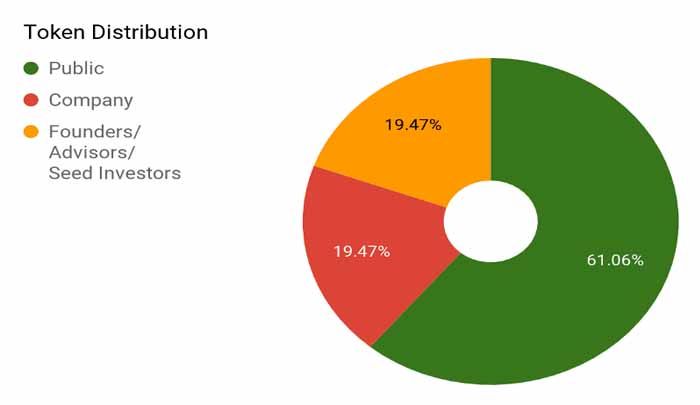
The company minted a total of 226,000,000 KNC during the ICO and distributed a little over 60% to public participants. There’s currently around 134,000,000 KNC in circulation. This number will fluctuate over the next two years as the founders and advisors’ token supply vests and enters the market.
Eventually, the burning will cause the circulating supply to decrease making the token deflationary. In combination with an increase in demand, this should ideally cause the price to increase. The cryptocurrency market is complicated, though, and there’s no guarantee of this happening.
Latest Kyber Network News
Kyber Network Mainnet Pilot is Now Live!
From everyone here at Kyber Network, huge thanks for the incredible support for our platform to date!!
Alas, we have come to one of the most important milestones in the Kyber Network history! Today marks the first time our platform runs on the Ethereum mainnet, and that means no more trading with testnet ETH for testnet ERC20 tokens!
We hope that our mainnet launch can help raise the awareness of decentralized exchanges in the minds of consumers and businesses so we can work towards scaling the impact of our the blockchain technology.
Pilot Launch on Mainnet
Our pilot launch on mainnet will run from February to April 2018. Each wallet address is only allowed to trade up to US$3,000 worth of Ether/tokens per transaction, with a US$15,000 daily limit that is refreshed at 12 AM (GMT+8). On top of that, the exchange service will exclude Singapore residents from utilizing Kyber Network for token conversion services, as we are still consolidating the tax matters related to Singaporeans’ participation in our network. This will be the arrangement until we have further clarity on tax requirements from the regulators.
- Overview - Table of Contents
- What Is Kyber Network?
- Getting Started With Kyber Network
- How To Get A Kyber Network Wallet?
- Kyber Network Resources
- How To Buy Kyber Network?
- How To Earn Kyber Network?
- Latest Kyber Network News
During the pilot phase, only KGT holders — Kyber Network’s whitelisted ICO contributors — will be granted access to the platform. As this is the first time Kyber Network’s platform will be deployed on the Ethereum mainnet, we want to ensure stability by scaling up user access in gradual batches. After a couple of weeks, we will monitor the traffic and probably allow more non-KGT holders to join the pilot launch on a request basis (more details on this will be made available later). To check if you are a KGT holder, please search for your address here on Etherscan.
